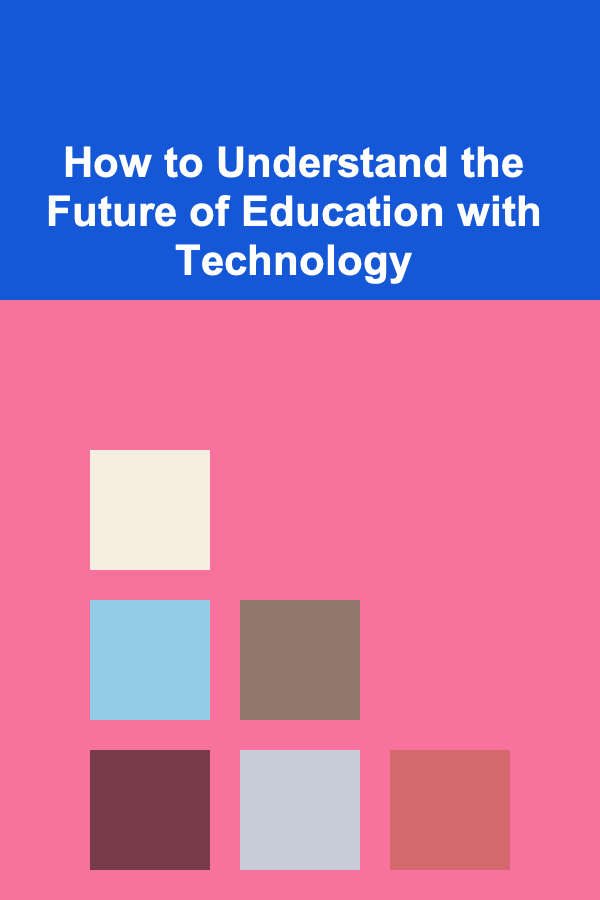
How to Understand the Future of Education with Technology
ebook include PDF & Audio bundle (Micro Guide)
$12.99$5.99
Limited Time Offer! Order within the next:

The future of education is an ever-evolving topic that sparks discussions worldwide. With technological advancements shaping every aspect of our lives, education is no exception. Over the past few decades, the landscape of education has changed dramatically, and as technology continues to advance at an accelerated pace, it has become increasingly essential to understand how these innovations will influence the future of learning.
Technology has the potential to transform education in ways that were once unimaginable. From personalized learning experiences to the rise of virtual classrooms, we are witnessing the dawn of a new era in education. This article explores how technology is reshaping education, its potential impact on the classroom, and the future skills students will need in an increasingly digital world.
The Rise of Digital Learning Platforms
In the past, education was largely confined to physical classrooms. Students learned through textbooks, lectures, and face-to-face interactions with teachers. However, with the advent of digital learning platforms, this model is evolving. The introduction of online courses, e-learning platforms, and educational apps has created new avenues for students to learn at their own pace, from anywhere in the world.
One of the most significant benefits of digital learning is its accessibility. Students no longer need to be physically present in a classroom to gain knowledge. Platforms like Coursera, Udemy, and Khan Academy allow learners to access high-quality educational content from some of the world's most prestigious universities and institutions. This shift is particularly important for individuals in remote areas or those with disabilities who may have previously faced barriers to education.
Moreover, digital learning platforms are not just for traditional students. Lifelong learning has become increasingly important as people are expected to continuously develop new skills throughout their careers. Online platforms provide adults with opportunities to upskill or reskill in response to changing job markets.
Personalized Learning and Adaptive Technologies
One of the most exciting aspects of the future of education is the potential for personalized learning experiences. Technology is making it possible to tailor educational content to individual students' needs, learning styles, and preferences. With the help of artificial intelligence (AI), machine learning, and data analytics, educators can create custom learning paths for each student.
In traditional classrooms, teachers often face the challenge of catering to the diverse needs of their students. Some students may need more time to grasp certain concepts, while others may be ready to move on to more advanced topics. With personalized learning, technology can track each student's progress and adjust the difficulty level of the material accordingly. This ensures that students are neither overwhelmed nor bored, but rather engaged at an optimal level for their personal development.
Adaptive technologies, such as intelligent tutoring systems, can provide real-time feedback and support. These systems are capable of assessing a student's performance and adjusting lessons to ensure they understand the material before moving on. This type of personalized, self-paced learning can significantly improve learning outcomes and help students retain information more effectively.
Virtual and Augmented Reality in Education
Virtual reality (VR) and augmented reality (AR) are revolutionizing the way students experience learning. These technologies allow students to engage with educational content in immersive and interactive ways that were once the stuff of science fiction.
In a VR-enabled classroom, students can explore historical events, conduct scientific experiments, or travel to distant locations---all without leaving their seats. For example, VR can take students on a virtual tour of ancient civilizations, allowing them to interact with artifacts and structures as if they were physically present. This kind of immersive experience is not only engaging but also enhances understanding by providing a deeper connection to the material.
AR, on the other hand, overlays digital content onto the real world. In a classroom setting, this could mean using AR glasses or apps to project 3D models of the human body or solar system onto a physical space. Students can interact with these models, making learning more hands-on and visual. AR also allows for real-time collaboration among students, as they can work together on shared virtual elements.
Both VR and AR have the potential to revolutionize education, particularly in fields like medicine, engineering, and the arts. These technologies provide experiential learning opportunities that traditional textbooks or classroom lectures cannot replicate.
The Role of Artificial Intelligence in Education
Artificial intelligence (AI) is perhaps one of the most powerful forces shaping the future of education. AI-powered tools and applications can enhance both teaching and learning experiences, making education more efficient and effective.
One of the most notable uses of AI in education is the development of chatbots and virtual assistants. These tools can provide immediate responses to students' questions, guide them through assignments, and even help with administrative tasks such as scheduling and grading. AI chatbots can be available 24/7, providing support to students at any time of day. This can be especially beneficial for students in different time zones or those who have non-traditional schedules.
AI can also assist teachers by automating administrative tasks, such as grading assignments and creating personalized learning materials. This allows educators to spend more time focusing on teaching and mentoring students rather than handling repetitive tasks. Moreover, AI can analyze student data to identify patterns in learning and performance, enabling teachers to intervene early when students are struggling or excelling.
The integration of AI into education is not limited to virtual assistants or chatbots. AI can be used to create personalized learning experiences by analyzing student data and adapting lesson plans accordingly. It can also help in assessing students' emotional states, providing insights into their engagement levels and well-being.
Gamification and Interactive Learning
Gamification is another trend that is gaining traction in the educational sector. By incorporating game elements into the learning process, educators can make learning more engaging and motivating for students. Gamified learning environments often involve earning points, unlocking achievements, and completing challenges---elements commonly found in video games.
The use of gamification in education has been shown to increase student engagement, motivation, and retention of information. By introducing an element of competition and reward, students are encouraged to participate actively in their learning and persist through challenges.
Interactive learning platforms, such as those that incorporate quizzes, simulations, and collaborative problem-solving tasks, provide students with opportunities to learn through play. These platforms can be especially effective in subjects that require critical thinking and problem-solving, such as mathematics, engineering, and coding.
Gamification is also useful for teaching soft skills like teamwork, leadership, and communication. Many online platforms use game-based scenarios to teach these skills in a safe, controlled environment. Students can learn by doing, making mistakes, and experimenting without real-world consequences.
The Impact of Technology on Traditional Classrooms
While technology is undoubtedly changing the landscape of education, it is important to recognize that traditional classrooms still play a vital role in the educational process. Technology is not meant to replace teachers but rather to enhance their ability to deliver education. The classroom of the future will likely be a blend of traditional teaching methods and cutting-edge technology.
Smartboards, interactive displays, and digital textbooks are becoming increasingly common in classrooms, making learning more interactive and engaging. Teachers can use technology to present multimedia content, such as videos and animations, to illustrate complex concepts. This helps cater to different learning styles and ensures that students stay engaged with the material.
Furthermore, technology can foster collaboration among students. Tools like Google Classroom and Microsoft Teams allow students to work together on projects, share resources, and communicate with peers and teachers in real-time. This enhances the sense of community within the classroom, even when students are learning remotely.
In the future, classrooms may become more flexible and adaptable, with students learning from home or in hybrid settings. As more schools adopt blended learning models, technology will be essential in bridging the gap between in-person and online education.
Preparing Students for the Future Workforce
As technology continues to transform industries, it is essential for education to prepare students for the workforce of the future. In a world where automation, artificial intelligence, and digital skills are becoming increasingly important, students must develop the skills necessary to thrive in a rapidly changing job market.
Skills such as coding, data analysis, and digital literacy will be essential in nearly every field. However, it is also important to foster critical thinking, creativity, and adaptability---skills that cannot be easily replicated by machines. The future workforce will require individuals who are not only tech-savvy but also capable of solving complex problems and thinking outside the box.
Moreover, the rise of remote work and digital collaboration means that students must also develop strong communication and collaboration skills. These soft skills, along with technical proficiency, will be crucial for success in the future job market.
Conclusion
The future of education with technology is exciting, offering unprecedented opportunities for learning and growth. From personalized learning experiences and virtual classrooms to the integration of artificial intelligence and gamification, technology is revolutionizing the way we approach education.
While there are many benefits to these innovations, it is important to remember that technology should complement, not replace, the role of teachers. The future of education will be a collaborative effort between educators, students, and technology, working together to create more engaging, inclusive, and effective learning experiences.
As we move forward, it is essential to ensure that all students have access to the tools and resources they need to succeed in this digital age. By embracing technology and preparing students for the future workforce, we can create a more equitable, dynamic, and innovative educational system that will benefit learners for generations to come.

How to Create a Budget for Home Maintenance and Upgrades
Read More
How to Promote Environmental Awareness in Children
Read More
How To Build a Relationship Based on Deep Understanding
Read More
How to Stay Motivated on Your Healthy Eating Journey
Read MoreHow to Use an Expense Tracker for Restaurant & Entertainment Expenses
Read More
10 Tips for Finding the Best Hidden Gems Snowboarding Spots
Read MoreOther Products

How to Create a Budget for Home Maintenance and Upgrades
Read More
How to Promote Environmental Awareness in Children
Read More
How To Build a Relationship Based on Deep Understanding
Read More
How to Stay Motivated on Your Healthy Eating Journey
Read MoreHow to Use an Expense Tracker for Restaurant & Entertainment Expenses
Read More